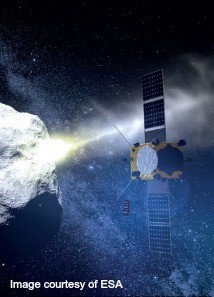GMV in the Asteriod Impact Mission

The last asteroid to pass close to the Earth was baptized as 2011 MD. This asteroid “buzzed” the Earth at a distance of 12,000 kilometers. It is estimated that asteroids over 1 km in diameter, capable of causing global catastrophes or mass extinctions, pass close to the Earth every few hundred thousand years. The European Space Agency has launched the Asteroid Impact Mission (AIM), targeted on the Dydimos asteroid with the objective of exploring and demonstrating technologies to pre-empt any devastating asteroid Earth impact.
GMV is playing a key part in AIM, with responsibility for mission analysis, the guidance, navigation and control (GNC) subsystem and an important part of operations design, in one of the two ESA studies currently underway. At the same time GMV’s Romanian subsidiary is developing the Hazard Avoidance and Fault Detection Isolation and Recovery (FDIR) function for the same mission. Last but not least GMV is leading one of the five concept studies for additional AIM science experiments with two CubeSats.
AIM is an active part of the Asteroid Impact and Deflection Assessment (AIDA) project of ESA, DLR (Germany), the Observatoire de la Côte d´Azur (France), NASA, and Johns Hopkins University Applied Physics Laboratory (JHU/APL), designed to assess the potential of the kinetic impactor concept for deflecting nearby asteroids. The second component of this mission is the DART satellite (Double Asteroid Redirection Test), which is American. AIM’s 200-million-euro budget places it among low-cost missions. The fate of the AIM mission is to be decided in the upcoming Ministerial Conference scheduled for late 2016. If approved, AIM would be launched in 2020 towards the Didymos asteroid. Arriving 18 months later, it would then begin its analysis of Didymoon while the binary asteroid system is passing about 11 million kilometers from Earth (30 times the Earth-Moon distance).
Once at the asteroid, AIM will study the secondary body Didymoon by means of two radars, the infrared camera TIRI (Thermal Imager) and the VIS camera (Visual Imaging System), which will build up a 1-meter resolution map. At the same time AIM will release two mini satellites for scientific research purposes and also the Lander MASCOT-2 of Germany’s Aerospace Center, DLR. One of the new features of this mission is use of the Optel-D laser communications system to send recorded information back to Earth, specifically to ESA’s Optical Ground Station (OGS) in Tenerife.
Finally, in 2022, AIM and DART will work jointly to determine the energy transfer resulting from DART’s impact against Didymoon.